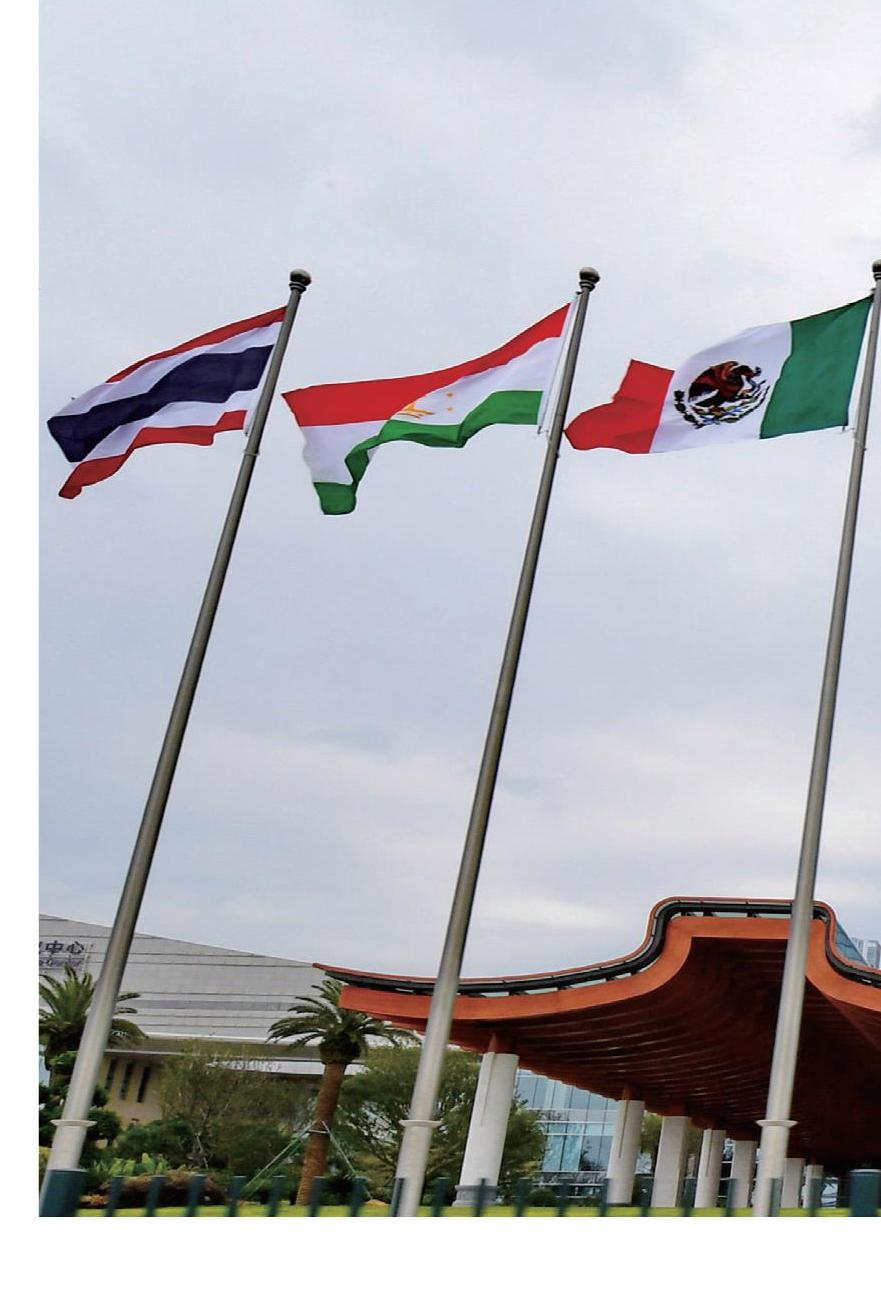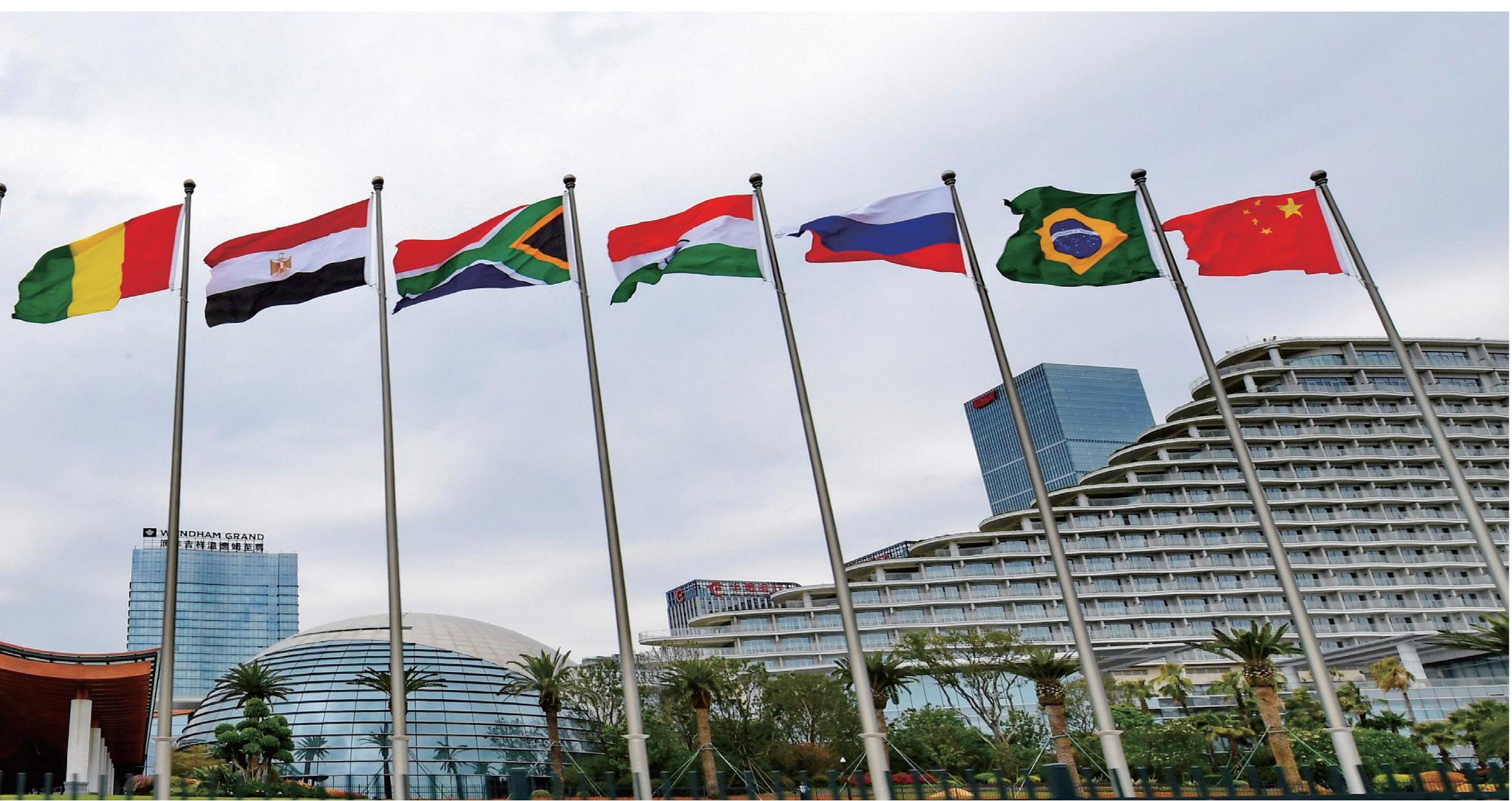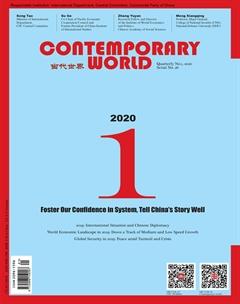“BRICS Plus” Cooperation Model and How China Has Innovated the Global Governance System
Wang Mingguo


Professor of the Law School,
Shanghai University of International Business and Economics
“BRICS Plus” cooperation model, as an institutional innovation of BRICS cooperation mechanism and a strategic measure of China to push forward the institutional building of global governance, is of critical significance. During the BRICS Summit held in Xiamen in September 2017, China initiated the “BRICS Plus” cooperation model, as a measure of institutional innovation. In the Dialogue between Emerging Market Economies and Developing Countries (EMDCs), themed “Promoting Mutually Beneficial Cooperation for Common Development”, the participants engaged in exchanges on such topics as “Implementing the Agenda for Sustainable Development” and “Building Extensive Partnerships on Development”. Through such in-depth discussion on development and cooperation, they reached broad consensus and injected strong impetus into deepening South-South cooperation and implementing the 2030 Agenda for Sustainable Development. In his speech at the BRICS Brasilia Summit on November 14th, 2019, Chinese President Xi Jinping pointed out that “We should expand ‘BRICS Plus cooperation within the frameworks of the United Nations and G20… We can leverage ‘BRICS Plus cooperation as a platform to increase dialogue with other countries and civilizations and win BRICS more friends and partners”. The successful practice of the “BRICS Plus” cooperation model marks the establishment of institutionalized cooperation between the BRICS and other developing countries. This will significantly enhance the cohesion among EMDCs, turn the BRICS into an epitome of South-South cooperation, and further push forward the profound transformation of the global governance system.
Practice of the “BRICS Plus”
Cooperation Model
Mechanism construction is the result of concrete actions.In practice, the “BRICS Plus” cooperation model is the outcome of long-term BRICS exploration. The “BRICS Plus” mutually beneficial cooperation model has taken shape during the BRICS Summit held in Durban, South Africa in March 2013. As the first BRICS Summit hosted on the African continent, the Durban Summit launched the BRICS-Africa Dialogue for the purpose of fostering partnerships between the BRICS and African countries. Under the theme of “BRICS Partnership with Africa”, the invited participants discussed about how to achieve openness, cooperation, mutual benefits and win-win results, showing the political will of both sides to seek common development on an equal and inclusive basis.
During the BRICS Summit in Fortaleza, Brazil in July 2014, the BRICS bloc held a dialogue on “Sustainable Solutions for Inclusive Growth” with Argentina, Mexico and other Latin American countries, extending BRICS cooperation wider to Latin America. With the participation of Brazil and Argentina, the two major economies of Latin America, the dialogue has helped the BRICS expand growing political and economic influence in Latin America.
During the 7th BRICS Summit in Ufa, Russia in July 2015, the BRICS held a dialogue with invited leaders of the member states and the observer states of the Eurasian Economic Union (EAEU) and the Shanghai Cooperation Organization (SCO), which are both regional cooperation organizations with considerable influence. The dialogue further expanded the “BRICS Plus” model of governance to bring the mutually beneficial BRICS cooperation with the world to the Eurasian continent.
During the BRICS Summit in Goa, India in October 2016, the BRICS leaders held a dialogue with leaders of Bay of Bengal Initiative for Multisectoral Technical Cooperation (BIMSTEC) member states, including Bangladesh, Bhutan, India, Myanmar, Nepal, Sri Lanka and Thailand. The dialogue has deepened the friendly relations between the BRICS and the BIMSTEC member states and through discussion on trade and economic relations and opportunities for investment cooperation, facilitated the joint efforts towards peace, development, democracy and prosperity.
During the BRICS “Year of Chinese Chairmanship” in 2017, China worked actively to develop and improve the mechanism of BRICS cooperation. Specific measures include hosting the Meeting of BRICS High Representatives for Security Issues and the Meeting of BRICS Ministers of Foreign Affairs/International Relations, establishing the mechanism of regular meetings among BRICS permanent representatives in New York, Geneva and Vienna and launching the New Development Bank (NDB) Africa Regional Center. A highlight is the Dialogue between EMDCs held in Xiamen, which represents Chinas most important innovation for the BRICS mechanism construction. The invited countries including Egypt, Guinea, Mexico, Tajikistan and Thailand represent major developing countries in the five regions of Middle East, Africa, Latin America, Central Asia and East Asia. This Dialogue has fostered more extensive partnerships on development, enhanced the BRICS influence over international regimes and extended BRICS influence to wider regions. In short, the evolution of the “BRICS Plus” reflects the common aspiration of the BRICS and developing countries to usher in the second “golden decade” of BRICS cooperation at a crucial stage of the BRICS institutional transformation.
During the BRICS Summit in Johannesburg, South Africa in July 2018, the second “BRICS Plus” Dialogue was held among the BRICS leaders and their counterparts from Africa and other EMDCs. The dialogue continued Chinese innovation of “BRICS Plus” model and enhanced its institutionalization. With over 20 African and other developing countries being invited, the dialogue has seen more members join the cooperation.
At the BRICS Summit in Brasilia in 2019, by tightening the ties between the BRICS leaders meeting and special mechanisms, China added new features to the “BRICS Plus” model. During the Summit, President Xi Jinping attended the closing ceremony of the BRICS Business Forum, closed-door and open meetings of BRICS leaders as well as the BRICS leaders dialogue with the BRICS Business Council and the New Development Bank. By making efforts to promote the establishment of new rules for international development financing, and to enhance the financing for infrastructure and sustainable development projects in the BRICS and other developing countries, he demonstrated Chinas firm determination to cement and innovate the “BRICS Plus” model through further efforts. In the meantime, with Chinas active efforts, Russia, the BRICS Chairperson for 2020, has suggested that the country would work close with China to upscale the “BRICS Plus” model and magnify the influence of the BRICS cooperation mechanism during the next BRICS Summit in St. Petersburg.
Before the “BRICS Plus” Dialogue in Xiamen, the “BRICS Plus” mutually beneficial cooperation has mainly been carried out in the form of “the BRICS plus Regional States” and “the BRICS plus Regional International Organizations”. But focusing on regional countries and regional international organizations fails to fully reflect the BRICS positioning as a global governance mechanism, and also fails to satisfy the expectations of the majority of developing countries for BRICS cooperation. The Dialogue among the EMDCs in Xiamen, engaged developing countries of different regions for the first time, turning the meeting into a truly effective platform for the BRICS and other developing countries to open up for mutually beneficial and win-win cooperation. Chinas institutional innovation of the “BRICS Plus” cooperation model, featuring the “BRICS Plus Cross-regional States”, has strengthened the cooperation between emerging market economies and developing countries, forged the collective identity of the BRICS as emerging market economies, and endowed the BRICS de facto governance mechanisms with global influence.
The Major Features of the
“BRICS Plus” Cooperation Model
First, the “BRICS Plus” cooperation model puts emphasis on expanding the geographical range. The Xiamen Dialogue among EMDCs, for the first time, invited major developing countries across Asia, America and Africa. Egypt, Guinea, Mexico, Tajikistan and Thailand are all major regional countries with enormous influence and major players in spheres of politics, economy and society in their respective regions. By targeting developing countries aspiration for governance and addressing their reasonable concerns, the “BRICS Plus” cooperation model encourages developing countries to engage in global governance, and also strengthen their voice in global governance and overall governance capability. Therefore, in the form of “5 plus 5”, the dialogue held during the Xiamen BRICS Summit discussed development plans and reached broad consensus on implementing the agenda for sustainable development, strengthening South-South cooperation, building partnerships on development, and improving global economic governance, so as to jointly make the international order more just and equitable.
Second, the “BRICS Plus” cooperation model is a flexible and gradual middle way to attract more members to the BRICS bloc. The BRICS mechanism is exerting growing influence on the vast number of developing countries, especially some emerging economies, and is attracting more attention to its expansion. The BRICS economic development and technological innovation have sparked increasing interest of developing countries, many of which attempt to join the bloc to stimulate investment, garner development aid and drive technological innovation. In recent years, Egypt, Mexico and other major regional countries have shown interest in joining the BRICS cooperation. However, the BRICS members havent reach an agreement on expansion. Individual BRICS members hold that further expansion will make policy coordination more difficult and defocus policy issues, and thus undermine the BRICS cohesion. Therefore, the second round of BRICS expansion is facing considerable uncertainties. In this context, the “BRICS Plus” cooperation model represents an elaborate preparation and prudent choice for further BRICS expansion.
Finally, the “BRICS Plus” cooperation model adheres to the principle of prioritizing development and commits to building bridges between the BRICS cooperation and the Belt and Road Initiative. President Xi Jinping pointed out at the Dialogue among EMDCs in Xiamen that development is the top priority for EMDCs and called for the international community to prioritize development in macro-policy coordination. Deepening development is an urgent need for the EMDCs. Economic and trade cooperation has always served as the cornerstone for BRICS cooperation and the priority of the Belt and Road Initiative. Therefore, Chinas efforts to enrich and innovate the “BRICS Plus” cooperation model are significant innovative measures to implement the 2030 Agenda for Sustainable Development, promote the world peace and development, and push forward the building of a community with shared future for humanity.
“BRICS Plus” Cooperation Model, as an Innovation of Global
Governance System
First, the “BRICS Plus” cooperation model fulfills the BRICS realistic demand for cementing the mechanism. As the BRICS is currently facing a new international situation, the BRICS members have different opinions on mechanism self-construction and specific approaches towards it. Some BRICS members suffer sluggish economy and the world is hearing noisy upbeat tones on the “Diminishing Relevance of BRICS”, “BRICS in Recession” and “the Fragile Five”. In view of such development, the BRICS should face up to their own problems and deepen mechanism construction. As President Xi Jinping pointed out, as a cooperation platform with global influence, BRICS cooperation is more than about our five countries. Rather, it carries the expectations of emerging market and developing countries and indeed the international community. As an innovation of the BRICS mechanism, the “BRICS Plus” cooperation model is conducive to expanding the BRICS scope of influence and benefits, fostering an open and diverse network of development partners, and engaging more EMDCs to work on the undertakings of solidarity, cooperation and mutual benefits. Institutionalizing the “BRICS Plus” cooperation model caters to the BRICS realistic needs for deepening institutional building. It is a critical strategic measure of China to contribute its wisdom and solutions.
Second, the “BRICS Plus” cooperation model is an important approach to enhance the BRICS voice in global governance. Institutional voice is a critical path to transform institutional power into international influence. Over a decade of development, the BRICS has a cooperation mechanism with annual leaders Summit as the core, a dozen ministerial meetings including those among security representatives, foreign ministers and finance ministers, and multi-level arrangements including the Business Council, the BRICS Think Tank Council, the Counter-Terrorism Working Group and the Information and Communication Technology Working Group. As the BRICS is facing mounting pressure and challenges to push forward the transition of global governance in recent years, the key to deepening BRICS mechanism construction lies in the effective solutions to the problems emerging in the adjustment and transformation process of global governance. The successful practice of the “BRICS Plus” cooperation model has extended the BRICS more rights over rule-making, agenda-setting and making the blocs voice heard.
Third, the “BRICS Plus” cooperation model is an important attempt by China to promote the reform of global governance system. Global governance is facing such immediate challenges as structural transformation and deficit of governance. Upon this background, China, as the worlds second largest economy, is playing a leading role in fostering a just and equitable international order through the launch of the Asian Infrastructure Investment Bank, Silk Road Fund and the Belt and Road Forum for International Cooperation. China and the vast majority of developing countries believe that global governance should keep pace with the times, adhere to the principle of seeking shared benefits through extensive consultation and joint contribution, and enhance the voice and representation of BRICS and EMDCs. As the BRICS expansion is not in sight, the “BRICS Plus” cooperation model helps to expand the BRICS cooperation platform, effectively connects the mechanism with the Belt and Road Initiative, and thus opens up wide space for furthering BRICS cooperation. During the Xiamen Dialogue among the EMDCs, China has pledged to provide US$500 million in aid and 40,000 training opportunities in China for other developing countries within the framework of South-South cooperation, marking Chinas concrete measures to act on its solemn commitment to promote the common prosperity of developing countries. In short, the institutional innovation of the “BRICS Plus” cooperation model reflects Chinas attitude to tighten ties and deepen cooperation between the BRICS and other developing countries and Chinas attempt to promote the reform of the global governance system.
Last but not least, the “BRICS Plus” cooperation model manifests the building of a new type of international relations. China is committed to building a new type of international relations featuring mutual respect, fairness and justice, and win-win cooperation. Such a new type of international relations, with both theoretical and practical significance, represents Chinas aspiration and vision for the future world as well as Chinas strong sense of responsibility. An important goal of forging the new-type international relations is to build a global partnership network by means of promoting political mutual trust, economic interdependence, cultural integration, social interaction and security support. Amid profound changes unseen in a century and in face of such challenges as the deficit of governance, trust, peace and development, the China-advocated “BRICS Plus” cooperation model has provided the way out for addressing the four deficits by expanding the BRICS sphere of influence. The institutional innovation of the “BRICS Plus” cooperation model marks a new start for BRICS cooperation and an important part of the new type of international relations.
In summary, as the BRICS cooperation ushers in the second decade, Chinas innovation of the “BRICS Plus” cooperation model is an important institutional choice in view of the respective and collective historical development of the five countries as well as the global development and changes in the international situation. The BRICS, as an important participant and contributor of global governance, contributes the “BRICS wisdom” and proposes the “BRICS solutions” in the spirit of openness, inclusiveness and win-win cooperation. Hereinto, the key is to strengthen communication, resolve differences and take gradual approaches to push forward the building of a community of common interests, concerted actions and shared future. To build “a community of concerted actions”, the BRICS needs to continuously strengthen their cohesion, intensify outreach dialogues, expand the “BRICS Plus” cooperation model, build broad partnerships and South-South cooperation platforms, facilitate the steady growth of the BRICS cooperation mechanism, and thus comprehensively elevate the overall BRICS cooperation. In short, EMDCs are the future of world development and the China-initiated “BRICS Plus” cooperation model provides a new direction for the development of global governance system.
- 当代世界英文版的其它文章
- Foster Our Confidence in System,Tell China’s Story Well
- 2019: International Situation and Chinese Diplomacy
- Global Security in 2019: Peace amid Turmoil and Crisis
- Readjustment of World Economic Pattern and Integration of Interests among BRICS States
- China-Russia Relations for a New Era: Experience Sharing and Strategic Cooperation between Ruling Parties
- Integration of Party Diplomacy, Ping-pong Diplomacy and Tea Talk Diplomacy

